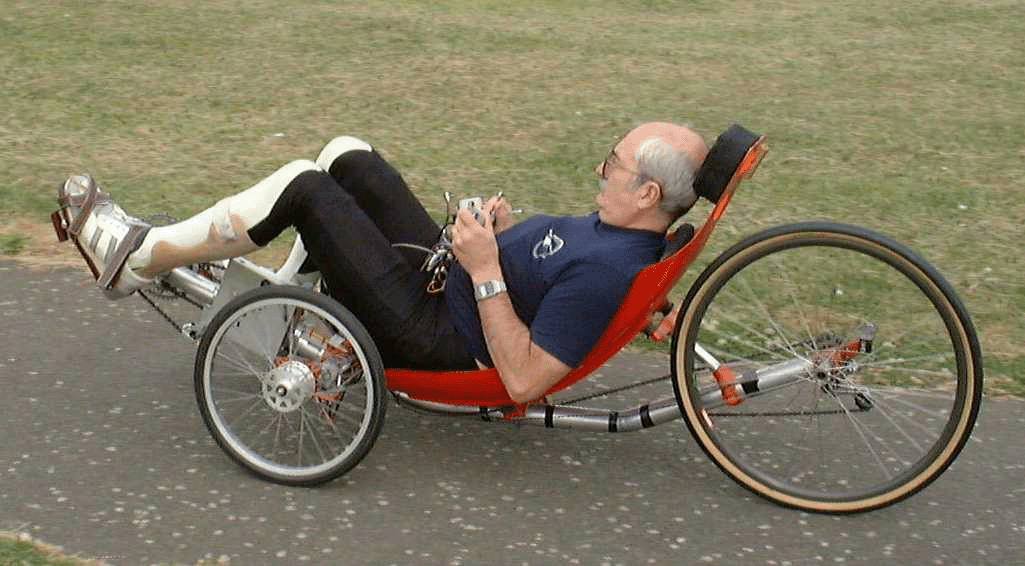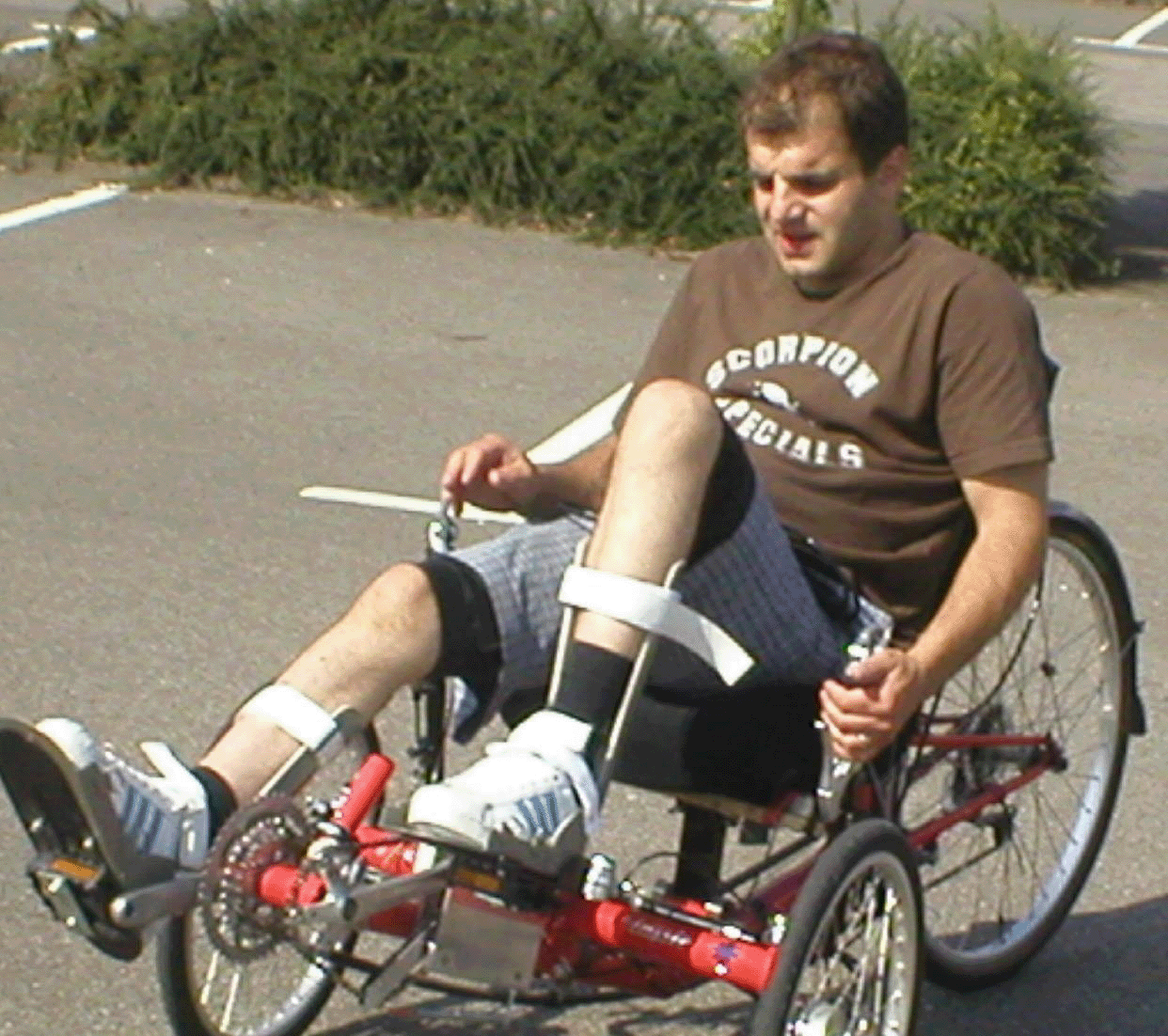|
Why do FES Cycling?
 FES Fact Sheet
by Dr Roger Fitzwater FES Fact Sheet
by Dr Roger Fitzwater
What is it?
The letters FES stand for Functional Electrical Stimulation. FES is the application of electrical impulses to paralysed muscles causing a series of contractions and relaxations creating a functional movement. The electrical impulses are applied to the muscles via electrodes placed on the skin above the muscles. Electrodes can also be surgically inserted on nerves or nerve roots that supply the muscles.
How does it work?
 Muscle contraction is an electrochemical process that is stimulated by an electric current and propagated through nerve and muscle cells. When an electrical potential is applied between two electrodes placed on the surface of the body electric current passes from one electrode to the other through the tissue. If the tissues contain any muscles they will contract during the passage of the electricity and relax when it stops. By controlling the timing of the electrical impulses and the positioning of the electrodes it is possible to create various patterns of muscle contraction and relaxations that can enable a paralysed limb to perform a function. Muscle contraction is an electrochemical process that is stimulated by an electric current and propagated through nerve and muscle cells. When an electrical potential is applied between two electrodes placed on the surface of the body electric current passes from one electrode to the other through the tissue. If the tissues contain any muscles they will contract during the passage of the electricity and relax when it stops. By controlling the timing of the electrical impulses and the positioning of the electrodes it is possible to create various patterns of muscle contraction and relaxations that can enable a paralysed limb to perform a function.
In FES cycling electrodes are placed on the skin over the gluteal (buttock), quadriceps (front of thigh), hamstrings (back of thigh), gastrocnemius (calf) and anterior tibial (shin) muscles. These muscles are stimulated sequentially in a pattern that enables the legs to turn cycle pedals. A suitably programmed stimulator using information about the position and speed of the pedals provided by a “shaft encoder” produces the correct type and pattern of stimulation.
History
The contraction of a muscle by the application of an external electric current was first demonstrated by Galvani in 1791. The use of FES in spinal cord injury has been the subject of research since the late Sixties. The major focuses of research have been bladder control, locomotion and manipulation. Considerable success has been obtained with bladder control but no useful FES walking method has been developed for those with complete spinal cord lesions. In the United States FES cycle ergometry exercise is available at some centres. In the UK a team from University College London has developed a more sophisticated form of FES cycling that uses a greater number of muscles and is applicable to "on road cycling" as well as cycle ergometry. FES rowing and FES armchair exercise are also available.
The benefits of FES exercise
Adequate exercise is essential for health. Exercise improves fitness and maintains function. It helps prevent obesity and diabetes. It protects against cardiovascular disease. It elevates mood and can help prevent depression. Those who exercise regularly get less ill health of all sorts and live longer.
The benefits of exercise are subject to the law of diminishing returns thus those who exercise the least, such as the disabled, have the most to gain from any increase in the amount of exercise that they take. It is impossible for those with tetraplegia to get adequate exercise and is difficult for those with paraplegia. FES cycling not only provides the general benefits of exercise but it does so without risk of overuse injury to the upper limbs and shoulder joints.
Most importantly FES cycling has the potential to provide some specific and very important extra benefits for those with a spinal cord injury. It can increase bone density decreasing the risk of fractures. It can prevent joint contractures. It improves the circulation, decreasing the likelihood of thrombosis. By increasing muscle bulk it can improve body image. Improving muscle bulk and circulation should help prevent pressure sores.
Provision of FES cycling
To get the maximum benefits from FES lower limb exercise it is necessary to stimulate the maximum possible number of muscle groups (5 per leg). Up until now there has been no stimulator available that will do this. (The stimulator used by the UCL team comes closest, stimulating four muscle groups per leg.) Another problem has been that the available stimulators have been designed for laboratory research applications and are therefore not necessarily user-friendly or robust.
A new stimulator has been developed that will stimulate 12 muscle groups and has been designed from the outset to be suitable for home use. It is hoped that this stimulator will be available in a few months and for the first time the spinal cord injured will have the opportunity to purchase the necessary equipment to benefit from FES cycling exercise in their own home outside of a research programme.
It is expected that the first centre to provide the necessary training service for FES cycling will be the new SIA headquarters in Milton Keynes.
Registering an interest
While FES cycle exercise will not be available at SIA headquarters for some months, anyone who wishes to register an interest should do so by e-mailing Dr Roger Fitzwater at rogfitz@hotmail.co.uk
Those who have already registered an interest in FES cycling research with Dr Roger Fitzwater need not re-register unless their details have changed.
Those in Scotland may also register an interest with Nicola Coffield at Glasgow University,tel: 0141 330 2468 or email ncoffield@mech.glac.ac.uk
|
![]() +44 (0)20 7679 0200 - Copyright © 1999-2005
UCL
+44 (0)20 7679 0200 - Copyright © 1999-2005
UCL